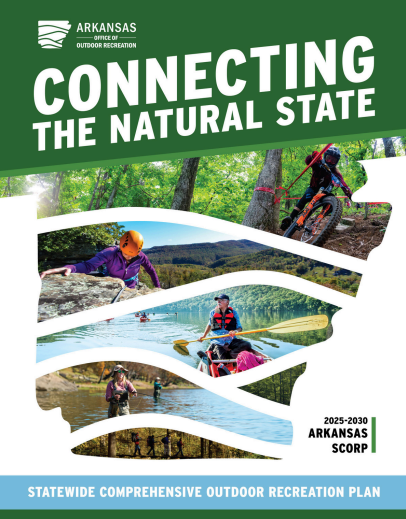LITTLE ROCK, Ark. — The Arkansas Office of Outdoor Recreation has released the 2025-2030 Statewide Comprehensive Outdoor Recreation Plan (SCORP), a five-year strategic guide that assesses the state’s outdoor recreation needs and sets priorities for future development. The document, funded in part by the Land and Water Conservation Fund (LWCF), is a requirement for continued eligibility for federal recreation funding.
A Nationwide Effort to Plan for Outdoor Recreation
Statewide Comprehensive Outdoor Recreation Plans (SCORPs) originated from the Land and Water Conservation Fund (LWCF) Act in the 1960s. This federal legislation aimed to bolster outdoor recreation across the United States by providing financial assistance to states. As a condition for receiving LWCF funding, states were required to develop SCORPs, which serve as strategic blueprints for outdoor recreation development. Over the decades, these plans have evolved, expanding their focus beyond simply acquiring land to encompass broader considerations like equitable access, resource conservation, and the impact of recreation on public health.
Today, SCORPs are essential tools for states to manage and enhance their outdoor recreation resources. They provide a framework for assessing current recreation needs, identifying priorities, and guiding future investments.
By analyzing trends in outdoor recreation participation and considering factors like population growth and environmental changes, SCORPs help states make informed decisions about resource allocation. These plans are regularly updated to ensure they remain relevant, allowing states to adapt to evolving recreation demands and maintain eligibility for vital federal funding. In this way, SCORPs play a critical role in ensuring that outdoor recreation opportunities are available and accessible for all.
 A Roadmap for Outdoor Recreation in The Natural State
A Roadmap for Outdoor Recreation in The Natural State
The latest SCORP, themed “Connecting The Natural State,” highlights Arkansas’ commitment to expanding and enhancing outdoor recreation opportunities. It emphasizes linking parks, trails, and green spaces through multimodal transportation options, fostering accessibility and conservation.
The plan is based on extensive research, including surveys of Arkansas residents and recreation providers, as well as town hall meetings across the state. Arkansas Tech University assisted in gathering and analyzing data for the plan.
In his opening letter to the SCORP, Arkansas Department of Parks, Heritage and Tourism Secretary, Shea Lewis said, “In these modern times we live in, the outdoors brings more importance than ever. Since the last SCORP, technology has leaped forward but has left many without the experience of adventure in our state. We see the work of our department as more important than ever—to welcome all into the Natural State and create a lasting impact for future generations.”
Identifying Barriers and Priorities
The SCORP identifies five primary barriers that limit participation in outdoor recreation: income inequality, physical impairments, lack of free time, lack of companionship, and concerns about safety. Addressing these barriers is a key focus of the plan.
According to Katherine Andrews, Director of the Arkansas Office of Outdoor Recreation, “The most important thing to remember is that the SCORP plan is just that—a plan. It takes into account the recreational opportunities available in the state and the opinions, suggestions, and wishes of the citizens who use those opportunities.”
To guide investment and development, SCORP outlines five strategic priorities:
- Sustain Community Investment – Supporting economic growth through outdoor recreation infrastructure.
- Improve Accessibility – Enhancing inclusivity for people of all abilities.
- Foster Outdoor Innovation – Leveraging technology and new ideas to expand outdoor opportunities.
- Support Public Wellness – Promoting health benefits through increased outdoor access.
- Promote Environmental Stewardship – Encouraging conservation and responsible recreation.
A Collaborative Effort
The SCORP was developed with input from an advisory board composed of state and local officials, outdoor recreation professionals, and conservation experts. The plan also includes case studies showcasing successful recreation projects and connectivity initiatives, such as the Maumelle Pinnacles Conservation Area.
Looking Ahead
With its focus on sustainability, accessibility, and innovation, the 2025-2030 SCORP serves as a guiding document for state agencies, municipalities, and recreation providers. It also plays a crucial role in securing federal and state grants for future projects.
For more information, the full report is available through the
Arkansas Office of Outdoor Recreation. The Society of Outdoor Professionals keeps a list of SCORPs from across the country along with more information on the SCORP process and details on the Land and Water Conservation Fund on their
website.
This article was originally published on ArkansasOutside.com, your trusted source for outdoor news and updates in The Natural State. Unless otherwise credited, all photos included in this piece are the property of Arkansas Outside, LLC. We take pride in sharing the beauty and adventures of Arkansas through our lens—thank you for supporting our work!
 A Roadmap for Outdoor Recreation in The Natural State
A Roadmap for Outdoor Recreation in The Natural State





